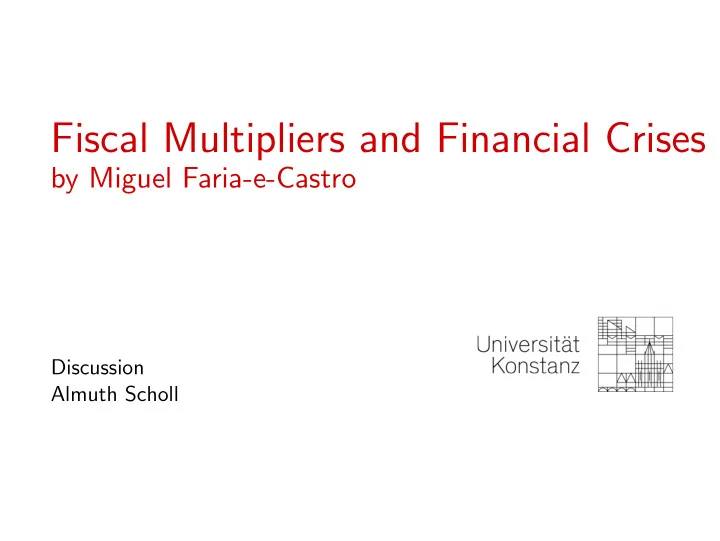

Fiscal Multipliers and Financial Crises by Miguel Faria-e-Castro Discussion Almuth Scholl
Contribution of the Paper 1-1 Contribution of the Paper Research Question ◮ What were the effects of fiscal policy on aggregate consumption during the Great Recession? ◮ government purchases ◮ transfers to households ◮ equity injections and transfers to the financial sector ◮ credit and asset guarantees
Contribution of the Paper 1-2 New Keynesian Model with Financial Sector ◮ Households: ◮ Two types who differ in their preference for housing. ◮ Savers invest in short-term bank deposits and government debt. ◮ Borrowers own houses, have long-term debt and face a loan-to-value constraint. ◮ A fraction m of the borrowers has to move, receives idiosyncratic housing quality shocks and may default.
Contribution of the Paper 1-3 ◮ Financial Sector: ◮ Banks have short-terms deposits and long-term debt. ◮ Banks face a leverage constraint: market value of assets has to be smaller than the ex-dividend market value of the bank. ◮ Banks are hit by idiosyncratic shocks to their asset portfolio and may default on deposits.
Contribution of the Paper 1-4 Quantitative Analysis and Findings ◮ Feeding observed fiscal measures into the model:
Contribution of the Paper 1-5 ◮ Given fiscal policies, estimation of TFP-shocks and credit shocks to match aggregate consumption and credit spreads:
Contribution of the Paper 1-6 ◮ Findings: ◮ Without fiscal interventions the fall in aggregate consumption would have been twice as worse. ◮ Transfers and equity injections were most effective. ◮ Fiscal multipliers are state-dependent.
Contribution of the Paper 1-7 ◮ Findings: ◮ Without fiscal interventions the fall in aggregate consumption would have been twice as worse. ◮ Transfers and equity injections were most effective. ◮ Fiscal multipliers are state-dependent. ◮ Channel: ◮ Transfers to borrowers sustain disposable income, increase house prices and reduce default rates → banks lend more at lower rates. ◮ Bank recapitalization reduces costs of funds and increases lending → disposable income of households increases.
Comments 2-1 Comments Distributional Effects and Welfare ◮ What are the distributional effects of the various fiscal interventions? ◮ In the counterfactual experiments, how are borrowers’ consumption and savers’ consumption affected? ◮ What are the welfare effects for savers and borrowers? What are the aggregate welfare effects?
Comments 2-2 Mapping Fiscal Policy Data to the Model ◮ Government Purchases G : ◮ The ARRA contained substantial amounts of government investment: infrastructure, energy. ◮ Distinction between government consumption and government investment may be important, see Drautzburg and Uhlig (2015).
Comments 2-3 Mapping Fiscal Policy Data to the Model ◮ Government Purchases G : ◮ The ARRA contained substantial amounts of government investment: infrastructure, energy. ◮ Distinction between government consumption and government investment may be important, see Drautzburg and Uhlig (2015). ◮ Transfers T b : ◮ ESA, ARRA and TARP contained various measures including tax cuts, transfers and help for borrowers/homeowners. ◮ Is it feasible to distinguish between the different measures? ◮ E.g., programs for homeowners in need. In the model: fraction m of borrowers that are hit by the house quality shock.
Comments 2-4 The Role of Durable Spending ◮ Berger and Vavra (2015): ◮ Durable adjustment is infrequent, particulary during recessions. ◮ Substantial state-dependence: Recessions lead to a decline in the probability of durable adjustment of 20 % (of selling/buying a house of 15 %). ◮ The fiscal stimulus packages contained subsidies to durable adjustment, e.g., Cash for Clunkers. ◮ How important are these fiscal tools? ◮ Decomposition of aggregate consumption: non-durable and durable.
Comments 2-5 The Role of the Zero Lower Bound ◮ There is a large literature analyzing the size of the government spending multiplier at the ZLB. ◮ How effective are the various fiscal interventions at the ZLB?
Comments 2-6 The Role of Credit to the Corporate Sector ◮ In the model, there is no interaction between the financial sector and the corporate sector. ◮ Including credit to the corporate sector may be important when analyzing the impact of equity injections.
Comments 2-7 Other Comments ◮ Financial crises are exogenous events. ◮ To evaluate the fit of the model, it would be informative to plot the non-targeted variables as well, in particular nominal interest rate, household debt, house prices, household default rate. ◮ Critical parameters, e.g., fraction of borrowers (homeowners) χ = 0 . 45. ◮ Maturity of government debt.
Conclusion 3-1 Conclusion ◮ Great paper on the effectiveness of various fiscal tools during the Great Recession. ◮ Contributions: ◮ Incorporation of a financial sector and equilibrium default in a New Keynesian model. ◮ Global solution method takes into account occasionally binding constraints and nonlinearities. ◮ Very insightful quantitative assessment.
Recommend
More recommend